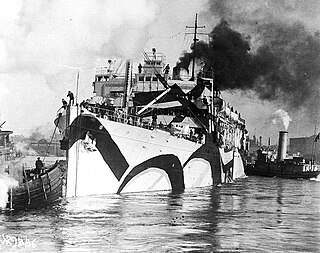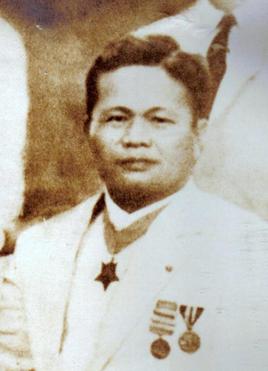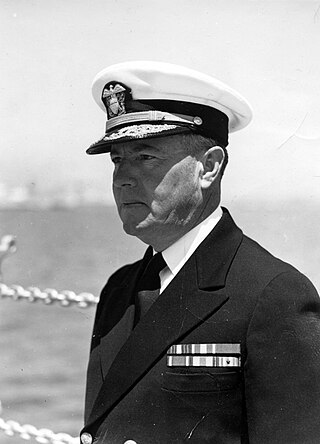
The seventh USS Washington (ACR-11/CA-11/IX-39), also referred to as "Armored Cruiser No. 11", and later renamed Seattle and reclassified CA-11 and IX-39, was a United States Navy Tennessee-class armored cruiser. She was laid down on 23 September 1903 at Camden, New Jersey, by the New York Shipbuilding Corporation, launched on 18 March 1905, sponsored by Miss Helen Stewart Wilson, daughter of United States Senator John L. Wilson of Washington state, and commissioned at the Philadelphia Navy Yard on 7 August 1906, Captain James D. Adams in command.

The Civil War Campaign Medal is considered the first campaign service medal of the United States Armed Forces. The decoration was awarded to members of the United States Armed Forces who had served in the American Civil War between 1861 and 1865.

Edward Walter Eberle was an admiral in the United States Navy, who served as Superintendent of the United States Naval Academy and the third Chief of Naval Operations.

The Sampson Medal was a U.S. Navy campaign medal. The medal was authorized by an Act of Congress in 1901. The medal was awarded to those personnel who served on ships in the fleet of Rear Admiral William T. Sampson during combat operations in the waters of the West Indies and Cuba. The Sampson Medal was also known as the West Indies Naval Campaign Medal, not to be confused with the West Indies Campaign Medal which was a separate award. A similar commemorative decoration was the Dewey Medal, considered senior to the Sampson Medal.
The American Defense Service Medal was a military award of the United States Armed Forces, established by Executive Order 8808, by President Franklin D. Roosevelt, on June 28, 1941. The medal was intended to recognize those military service members who had served on active duty between September 8, 1939, and December 7, 1941.

Edward David Taussig was a decorated Rear Admiral in the United States Navy. He is best remembered for being the officer to claim Wake Island after the Spanish–American War, as well as accepting the physical relinquishment of Guam by its Spanish governor following the Treaty of Paris in which Spain ceded Guam to the United States following nearly 300 years of colonial rule. Taussig briefly served as Governor of Guam. He was the first of a four-generational family of United States Naval Academy graduates including his son, Vice Admiral Joseph K. Taussig (1877–1947), grandson Captain Joseph K. Taussig Jr. (1920–1999), and great-grandson, Captain Joseph K. Taussig USMC (1945–).
The Spanish Campaign Medal was a military award of the United States Armed Forces which recognized those men of the U.S. military who had served in the Spanish–American War. Although a single decoration, there were two versions of the Spanish Campaign Medal, one for men of the United States Army and another for the forces of the United States Navy and United States Marine Corps.
The Cuban Pacification Medal (Army) is a military award of the United States Army which was created by orders of the United States War Department on May 11, 1909. The medal was created to recognize service during the United States occupation of Cuba from 1906 to 1909.
The Army of Puerto Rican Occupation Medal was a service medal of the United States Army which was created by order of the United States War Department on 4 February 1919. A retrospective award created decades after the action commemorated, the medal recognized Army service from 14 August through 10 December 1898 in Puerto Rico. The Army of Puerto Rican Occupation Medal was commemorative by nature although was approved for wear on active military uniforms. A similar medal, the Army of Cuban Occupation Medal was created for occupation service in Cuba following the Spanish–American War. The regulations for the Army of Cuban Occupation Medal were re-written to include regulations for the Army of Puerto Rican Occupation Medal.
The Second Nicaraguan Campaign Medal is a campaign medal of the United States Navy which was authorized by an act of the United States Congress on 8 November 1929. The Second Nicaraguan Campaign Medal was awarded for service during operations in Nicaragua from 1926 to 1933, during the Nicaraguan civil war and the subsequent occupation. An earlier campaign medal, the Nicaraguan Campaign Medal, was awarded for service in Nicaragua 1912.

USS Comfort (AH-3) was a hospital ship for the United States Navy in World War I. She was the sister ship of USS Mercy (AH-4) but the two ships were not of a ship class. Comfort was known as SS Havana in passenger service for the Ward Line, and as USAT Havana in United States Army service before her Navy service. Her name was restored to Havana in 1927, and she was renamed SS Yucatán in 1935, and SS Agwileon in 1941. In World War II, she was known as USAT Agwileon and USAHS Shamrock in service for the United States Army.

Vice Admiral Daniel Edward Barbey was an officer in the United States Navy who served in World War I and World War II. A graduate of the Naval Academy, he participated in the 1912 United States occupation of Nicaragua and the 1915 United States occupation of Veracruz. While serving with the War Plans Section of the Bureau of Navigation in Washington, D.C. between the World Wars, developed an interest in amphibious warfare. In 1940 he produced Fleet Training Publication 167 – Landing Operations Doctrine, United States Navy, which would become the Navy's "bible" of amphibious operations, and would remain in use throughout World War II.

USS Orizaba (ID-1536/AP-24) was a transport ship for the United States Navy in both World War I and World War II. She was the sister ship of Siboney but the two were not part of a ship class. In her varied career, she was also known as USAT Orizaba in service for the United States Army, and as SS Orizaba in interwar civilian service for the Ward Line, and as Duque de Caxias (U-11) as an auxiliary in the Brazilian Navy after World War II.

William Freeland Fullam was an officer in the United States Navy during World War I.

Brigadier General Albertus Wright Catlin was a United States Marine Corps general. He also was a recipient of the Medal of Honor for his services during the Occupation of Veracruz in 1914.

Telesforo de la Cruz Trinidad was a Filipino fireman 2nd class in the United States Navy who received the Medal of Honor for actions in Mexican waters near La Paz, on board the USS San Diego on 21 January 1915. He is the second service member, and first and so far only sailor of Asian descent to receive the award in peacetime. Trinidad served during both World Wars before retiring to the Philippines and living on his pension.
Hispanics in the United States Navy can trace their tradition of naval military service to men such as Lieutenant Jordi Farragut Mesquida, who served in the American Revolution. Hispanics, such as Seaman Philip Bazaar and Seaman John Ortega, have distinguished themselves in combat and have been awarded the Medal of Honor, the highest military decoration of the United States. Hispanics have also reached the top ranks of the navy, serving their country in sensitive leadership positions on domestic and foreign shores. Among those who have reached the highest ranks in the navy are Commodore Uriah Phillips Levy, of Sephardic and Ashkenazic Jewish descent, who participated in the War of 1812 as an assistant Sailing master; Admiral David Glasgow Farragut, for whom the rank of admiral in the U.S. Navy was created during the American Civil War; and Admiral Horacio Rivero, who led the navy during the Cuban Missile Crisis.

John Wills Greenslade was a highly decorated officer in the United States Navy with the rank of Vice Admiral. He enjoyed a significant military career, participating in several conflicts and distinguished himself during World War I as Commanding officer, USS Housatonic and during World War II as Commander, Western Sea Frontier and Commandant, Twelfth Naval district with headquarters at Mare Island Naval Shipyard.

John Howard Hoover was a United States Navy admiral who held several flag commands during World War II most notably those in the Central Pacific under Chester W. Nimitz. Hoover became one of Nimitz's trusted if little known admirals of the Pacific war.

Laurance Toombs DuBose was a highly decorated officer in the United States Navy with the rank of four-star Admiral. A veteran of several conflicts, including both World Wars, he distinguished himself several times as Commanding officer of heavy cruiser USS Portland and Commander, Cruiser Division 13 in the Pacific theater of World War II and received three awards of Navy Cross, the United States Navy second-highest decoration awarded for valor in combat.














